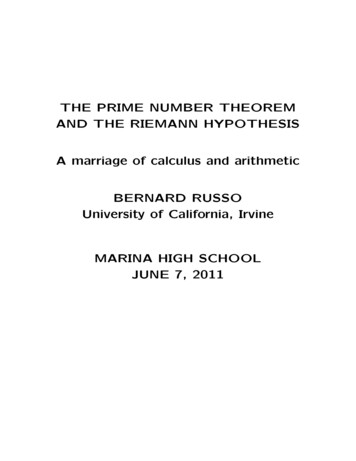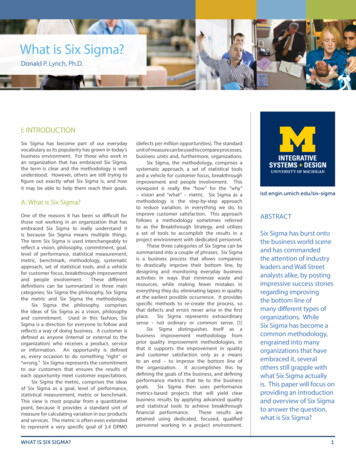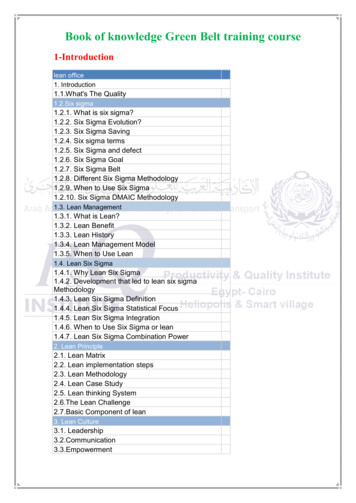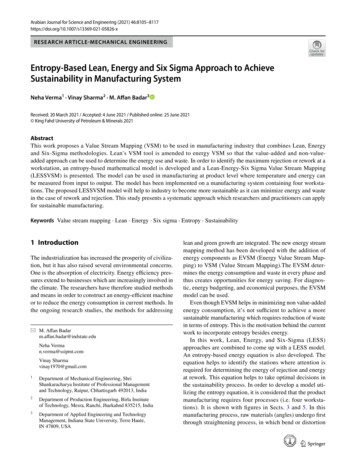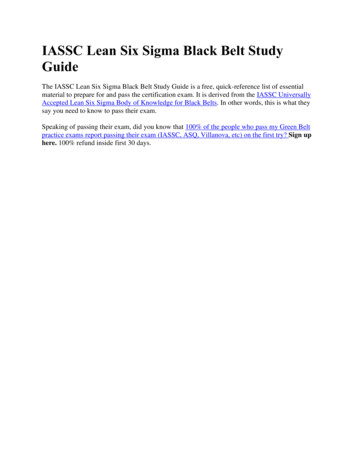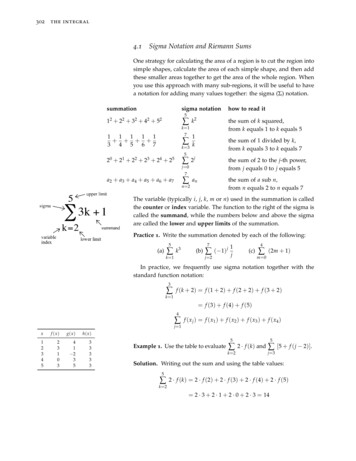
Transcription
302the integral4.1Sigma Notation and Riemann SumsOne strategy for calculating the area of a region is to cut the region intosimple shapes, calculate the area of each simple shape, and then addthese smaller areas together to get the area of the whole region. Whenyou use this approach with many sub-regions, it will be useful to havea notation for adding many values together: the sigma (Σ) notation.summationsigma notation512 22 32 42 52 k271khow to read itthe sum of k squared,from k equals 1 to k equals 5k 11 1 1 1 1 3 4 5 6 7 k 35 20 21 22 23 24 25the sum of 1 divided by k,from k equals 3 to k equals 72jthe sum of 2 to the j-th power,from j equals 0 to j equals 5anthe sum of a sub n,from n equals 2 to n equals 7j 07 a2 a3 a4 a5 a6 a7n 2The variable (typically i, j, k, m or n) used in the summation is calledthe counter or index variable. The function to the right of the sigma iscalled the summand, while the numbers below and above the sigmaare called the lower and upper limits of the summation.Practice 1. Write the summation denoted by each of the following:5 (a)k37(b) ( 1) jj 2k 11j4(c) (2m 1)m 0In practice, we frequently use sigma notation together with thestandard function notation:3 f ( k 2) f (1 2) f (2 2) f (3 2)k 1 f (3) f (4) f (5)4 f ( x j ) f ( x1 ) f ( x2 ) f ( x3 ) f ( x4 )j 1xf (x)g( x )h( x )123452310341 235333335Example 1. Use the table to evaluate k 252 · f (k ) and [5 f ( j 2)].j 3Solution. Writing out the sum and using the table values:5 2 · f ( k ) 2 · f (2) 2 · f (3) 2 · f (4) 2 · f (5)k 2 2 · 3 2 · 1 2 · 0 2 · 3 14
4.1 sigma notation and riemann sums303while:5 [5 f ( j 2)] [5 f (3 2)] [5 f (4 2)] [5 f (5 2)]j 3 [5 f (1)] [5 f (2)] [5 f (3)] [5 2] [5 3] [5 1]Jwhich adds up to 21.Practice 2. Use the values in the preceding margin table to evaluate:5(a) 4g(k)(b) 5h( j)(c)j 1k 2 [ g(k) f (k 1)]k 3Example 2. For f ( x ) x2 1, evaluate3 f ( k ).k 0Solution. Writing out the sum and using the function values:3 f ( k ) f (0) f (1) f (2) f (3)k 0 02 1 12 1 22 1 32 1 1 2 5 10Jwhich adds up to 18.Practice 3. For g( x ) 1, evaluatex4 3g(k ) andk 2 g ( k 1).k 1The summand need not contain the index variable explicitly: youcan write a sum from k 2 to k 4 of the constant function f (k) 54as 4f (k) ork 2 5 5 5 5 3 · 5 15. Similarly:k 27 2 2 2 2 2 2 5 · 2 10k 3Because the sigma notation is simply a notation for addition, it possesses all of the familiar properties of addition.Summation Properties:nSum of Constants: C C C C ··· C n·C ( a k bk ) ( a k bk ) C · ak C ·k 1nAddition:nk 1nSubtraction:k 1 ak akk 1nk 1nConstant Multiple:nak k 1nk 1 bk bkk 1nk 1Problems 16 and 17 illustrate that similar patterns for sums of products andquotients are not valid.
304the integralSums of Areas of RectanglesIn Section 4.2, we will approximate areas under curves by buildingrectangles as high as the curve, calculating the area of each rectangle,and then adding the rectangular areas together.Example 3. Evaluate the sum of the rectangular areas in the marginfigure, then write the sum using sigma notation.Solution. The sum of the rectangular areas is equal to the sum of(base) · (height) for each rectangle: 11147 (1) (1) (1)345605which we can rewrite as k 31using sigma notation.kJPractice 4. Evaluate the sum of the rectangular areas in the marginfigure, then write the sum using sigma notation.The bases of these rectangles need not be equal. For the rectangularareas associated with f ( x ) x2 in the margin figure:rectanglebaseheightarea1233 1 24 3 16 4 2f (2) 4f (4) 16f (5) 252·4 81 · 16 162 · 25 50so the sum of the rectangular areas is 8 16 50 74.Example 4. Write the sum of the areas of the rectangles in the marginfigure using sigma notation.Solution. The area of each rectangle is (base) · (height):rectanglebaseheightarea123x1 x0x2 x1x3 x2f ( x1 )f ( x2 )f ( x3 )( x1 x0 ) · f ( x1 )( x2 x1 ) · f ( x2 )( x3 x2 ) · f ( x3 )The area of the k-th rectangle is ( xk xk 1 ) · f ( xk ), so we can express3the total area of the three rectangles as ( x k x k 1 ) · f ( x k ).Jk 1Practice 5. Write the sum of the areas of the shaded rectangles in themargin figure using sigma notation.
4.1 sigma notation and riemann sumsArea Under a Curve: Riemann SumsSuppose we want to calculate the area between the graph of a positivefunction f and the x-axis on the interval [ a, b] (see below left).One method to approximate the area involves building several rectangles with bases on the x-axis spanning the interval [ a, b] and withsides that reach up to the graph of f (above right). We then computethe areas of the rectangles and add them up to get a number calleda Riemann sum of f on [ a, b]. The area of the region formed by therectangles provides an approximation of the area we want to compute.Example 5. Approximate the area shown in the margin between thegraph of f and the x-axis spanning the interval [2, 5] by summing theareas of the rectangles shown in the lower margin figure.Solution. The total area is (2)(3) (1)(5) 11 square units.JIn order to effectively describe this process, some new vocabulary ishelpful: a partition of an interval and the mesh of a partition.A partition P of a closed interval [ a, b] into n subintervals consistsof a set of n 1 points { x0 a, x1 , x2 , x3 , . . . , xn 1 , xn b} listed inincreasing order, so that a x0 x1 x2 x3 . . . xn 1 xn b.(A partition is merely a collection of points on the horizontal axis,unrelated to the function f in any way.)The points of the partition P divide [ a, b] into n subintervals:These intervals are [ x0 , x1 ], [ x1 , x2 ], [ x2 , x3 ], . . . , [ xn 1 , xn ] with lengths x1 x1 x0 , x2 x2 x1 , x3 x3 x2 , . . . , xn xn xn 1 .The points xk of the partition P mark the locations of the vertical linesfor the sides of the rectangles, and the bases of the rectangles have305
306the integrallengths xk for k 1, 2, 3, . . . , n. The mesh or norm of a partition P isthe length of the longest of the subintervals [ xk 1 , xk ] or, equivalently,the maximum value of xk for k 1, 2, 3, . . . , n.For example, the set P {2, 3, 4.6, 5.1, 6} is a partition of the interval[2, 6] (see margin) that divides the interval [2, 6] into four subintervalswith lengths x1 1, x2 1.6, x3 0.5 and x4 0.9, so the meshof this partition is 1.6, the maximum of the lengths of the subintervals.(If the mesh of a partition is “small,” then the length of each one of thesubintervals is the same or smaller.)Practice 6. P {3, 3.8, 4.8, 5.3, 6.5, 7, 8} is a partition of what interval? How many subintervals does it create? What is the mesh of thepartition? What are the values of x2 and x2 ?A function, a partition and a point chosen from each subinterval determine a Riemann sum. Suppose f is a positive functionon the interval [ a, b] (so that f ( x ) 0 when a x b), P { x0 a, x1 , x2 , x3 , . . . , xn 1 , xn b} is a partition of [ a, b], and ck is anx-value chosen from the k-th subinterval [ xk 1 , xk ] (so xk 1 ck xk ).Then the area of the k-th rectangle is:f (ck ) · ( xk xk 1 ) f (ck ) · xkDefinition:nA summation of the form f (ck ) · xk is called a Riemann sumk 1of f for the partition P and the chosen points {c1 , c2 , . . . , cn }.This Riemann sum is the total of the areas of the rectangular regionsand provides an approximation of the area between the graph of f andthe x-axis on the interval [ a, b].1using the partitionx{1, 4, 5} and the values c1 2 and c2 5 (see margin).Example 6. Find the Riemann sum for f ( x ) Solution. The two subintervals are [1, 4] and [4, 5], hence x1 3 and x2 1. So the Riemann sum for this partition is:2 f (ck ) · xk f (c1 ) · x1 f (c2 ) · x2k 1 f (2) · 3 f (5) · 1 1117·3 ·1 2510The value of the Riemann sum is 1.7.Practice 7. Calculate the Riemann sum for f ( x ) {1, 4, 5} using the chosen values c1 3 and c2 4.J1on the partitionx
4.1 sigma notation and riemann sums3071xcan have using the partition {1, 4, 5}? (You will need to choose valuesfor c1 and c2 .) What is the largest value a Riemann sum can have forthis function and partition?Practice 8. What is the smallest value a Riemann sum for f ( x ) The table below shows the output of a computer program that calcu1lated Riemann sums for the function f ( x ) with various numbersxof subintervals (denoted n) and different ways of choosing the pointsck in each subinterval.nmeshck left edge xk 1ck “random” pointck right edge 1.5144061.5702371.6054461.609038When the mesh of the partition is small (and the number of subintervals,n, is large), it appears that all of the ways of choosing the ck locationsresult in approximately the same value for the Riemann sum. For thisdecreasing function, using the left endpoint of the subinterval alwaysresulted in a sum that was larger than the area approximated by thesum. Choosing the right endpoint resulted in a value smaller than thatarea. Why?Example 7. Find the Riemann sum fornthe functionf ( x ) sin( x )π π oon the interval [0, π ] using the partition 0, , , π and the chosen4 2ππ3πand c3 .points c1 , c2 424h πi hπ πiSolution. The three subintervals (see margin) are 0,,,and44 2hπ i, π so x1 π4 , x2 π4 and x3 π2 . The Riemann sum for this2partition is:3 k 1 π π π π3ππ· sin· sin·442442 2 ππ2 π(2 3 2) π · 1· · 244228f (ck ) · xk sinor approximately 2.45148.JPractice 9. Find the Riemann sum for the function and partition in theππand c3 .22previous Example, but this time choose c1 0, c2 As the mesh gets smaller, all of the Riemann Sums seem to be approaching thesame value, approximately 1.609. (As weshall soon see, these values are all approaching ln(5) 1.609437912.)
308the integralTwo Special Riemann Sums: Lower and Upper SumsTwo particular Riemann sums are of special interest because they represent the extreme possibilities for a given partition.We need f to be continuous in order toassure that it attains its minimum andmaximum values on any closed subinterval of the partition. If f is bounded — butnot necessarily continuous — we can generalize this definition by replacing f (mk )with the greatest lower bound of all f ( x )on the interval and f ( Mk ) with the leastupper bound of all f ( x ) on the interval.Definition:If f is a positive, continuous function on [ a, b] and P is a partitionof [ a, b], let mk be the x-value in the k-th subinterval so that f (mk ) isthe minimum value of f on that interval, and let Mk be the x-valuein the k-th subinterval so that f ( Mk ) is the maximum value of f onthat subinterval. Then:nLSP f (mk ) · xk is the lower sum of f for Pk 1nUSP f ( Mk ) · xk is the upper sum of f for Pk 1Geometrically, a lower sum arises from building rectangles underthe graph of f (see first margin figure) and every lower sum is less thanor equal to the exact area A of the region bounded by the graph of fand the x-axis on the interval [ a, b]: LSP A for every partition P .Likewise, an upper sum arises from building rectangles over thegraph of f (see second margin figure) and every upper sum is greaterthan or equal to the exact area A of the region bounded by the graph off and the x-axis on the interval [ a, b]: USP A for every partition P .Together, the lower and upper sums provide bounds on the size ofthe exact area: LSP A USP .For any ck value in the k-th subinterval, f (mk ) f (ck ) f ( Mk ), so,nfor any choice of the ck values, the Riemann sum RSP f (ck ) · xkk 1satisfies the inequality:n k 1f (mk ) · xkn k 1f (ck ) · xkn f ( Mk ) · xkk 1or, equivalently, LSP RSP USP . The lower and upper sumsprovide bounds on the size of all Riemann sums for a given partition.The exact area A and every Riemann sum RSP for partition P andany choice of points {ck } both lie between the lower sum and the uppersum for P (see margin). Therefore, if the lower and upper sums areclose together, then the area and any Riemann sum for P (regardless ofhow you choose the points ck ) must also be close together. If we knowthat the upper and lower sums for a partition P are within 0.001 unitsof each other, then we can be sure that every Riemann sum for partitionP is within 0.001 units of the exact area A.
4.1 sigma notation and riemann sumsUnfortunately, finding minimums and maximums for each subinterval of a partition can be a time-consuming (and tedious) task, so it isusually not practical to determine lower and upper sums for “wiggly”functions. If f is monotonic, however, then it is easy to find the valuesfor mk and Mk , and sometimes we can even explicitly calculate thelimits of the lower and upper sums.For a monotonic, bounded function we can guarantee that a Riemann sum is within a certain distance of the exact value of the area itis approximating.Theorem:Iff is a positive, monotonic, bounded function on [ a, b]then for any partition P and any Riemann sum for f using P , RSP A USP LSP f (b) f ( a) · (mesh of P )Proof. The Riemann sum and the exact area are both between the upperand lower sums, so the distance between the Riemann sum and the exactarea is no bigger than the distance between the upper and lower sums.If f is monotonically increasing, we can slide the areas representing thedifference of the upper and lower sums into a rectangle:309Recall from Section 3.3 that “monotonic”means “always increasing or always decreasing” on the interval in question.In words, this string of inequalities saysthat the distance between any Riemannsum and the area being approximated isno bigger than the difference between theupper and lower Riemann sums for thesame partition, which in turn is no bigger than the distance between the valuesof the function at the endpoints of theinterval times the mesh of the partition.See Problem 56 for the monotonically decreasing case.whose height equals f (b) f ( a) and whose base equals the mesh of P .So the total difference of the upper and lower sums is smaller than thearea of that rectangle, [ f (b) f ( a)] · (mesh of P ).4.1 ProblemsIn Problems 1–6 , rewrite the sigma notation as asummation and perform the indicated addition.41. k 2k233. (1 j )j 154.n 152. (1 n )2 j 03cos(πj)sin(πk )k 055. 6. k 11k
310the integralIn Problems 7–12, rewrite each summation using thesigma notation. Do not evaluate the sums.325.27.9. 9 16 25 36 · · · 1443 33310. ··· 4 9 1610011. 1 · 21 2 · 22 3 · 23 · · · 7 · 27In Problems 13–15, use this table:akbk123123222 k 13k 1314. 15. ( a k bk ) k 1333.ak k 1 bk a k · bk 6 k 1k 1317. a2k 6 ak6 bkk 1318.k 1 8 11 kk 1h k 1 ik bk39. P { 3, 1, 0, 1.5, 2}40. P as shown below:k 1akakbk41. P as shown below:2For 19–30, f ( x ) x2 , g( x ) 3x and h( x ) .xEvaluate each sum.319.21.3 f (k)20.k 0332 · f ( j)22.j 0 m 1 f (2k )42. P as shown below:f (1 i )i 0323. k 0 3g(m)4 34.24. k 1k 3 ( k 1)3ih( k 1)3 k 3ik 05 36.[ x k x k 1 ]k 138. P {3, 3.6, 4, 4.2, 5, 5.5, 6}!23k 1 3k 1 3k 1 hk 1 37. P {2, 3, 4.5, 6, 7}3ak 32. k 1For Problems 16–18, use the values of ak and bk inthe table above to verify the inequality.!!16. 6imesh of P and (d) calculateak35k 2 ( k 1)2nk 1k 13g(k) · h(k)In 37–43, (a) list the subintervals determined by thepartition P , (b) find the values of xk , (c) find the35ak 5 ·hk 0bk 30.k 1 k 1k 13k 17f (n) · h(n)k 135. h(3i )i 1n 131.3ak 28.329.7k4h(k)k 2to verify the equality for these values of ak and bk .( a k bk ) k · g(k)k 1In 31–36, write out each summation and simplify theresult. These are examples of “telescoping sums.”12. 3 6 9 · · · 3013. 26.48. 4 6 8 · · · 2433g2 ( j )j 17. 3 4 5 · · · 93 943 g ( f (k)) xk .
4.1 sigma notation and riemann sums43. For xk xk xk 1 , verify that:n xk length of the interval [ a, b]k 1For 44–48, sketch a graph of f , draw vertical lines ateach point of the partition, evaluate each f (ck ) andsketch the corresponding rectangle, and calculateand add up the areas of those rectangles.31152. f ( x ) x2 2x 3(a) P {0, 2, 3}(b) P {0, 1, 2, 3}(c) P {0, 0.5, 1, 2, 2.5, 3}53. Suppose LSP 7.362 and USP 7.402 for apositive function f and a partition P of [1, 5].(a) c1 1, c2 3, c3 3(a) You can be certain that every Riemann sum forthe partition P is within what distance of theexact value of the area between the graph of fand the x-axis on the interval [1, 5]?(b) c1 2, c2 2, c3 4(b) What if LSP 7.372 and USP 7.390?44. f ( x ) x 1, P {1, 2, 3, 4}45. f ( x ) 4 x2 ,P {0, 1, 1.5, 2}(a) c1 0, c2 1, c3 2(b) c1 1, c2 1.5, c3 1.5 46. f ( x ) x, P {0, 2, 5, 10}(a) c1 1, c2 4, c3 9(b) c1 0, c2 3, c3 7 47. f ( x ) sin( x ), P 0, π4 , π2 , πππ(a) c1 0, c2 , c3 42ππ(b) c1 , c2 , c3 π4248. f ( x ) 2x , P {0, 1, 3}(a) c1 0, c2 2(b) c1 1, c2 3For 49–52, sketch the function and find the smallestpossible value and the largest possible value for aRiemann sum for the given function and partition.49. f ( x ) 1 x254. Suppose you divide the interval [1, 4] into 100equally wide subintervals and calculate a Riemann sum for f ( x ) 1 x2 by randomly selecting a point ck in each subinterval.(a) You can be certain that the value of the Riemann sum is within what distance of the exactvalue of the area between the graph of f andthe x-axis on interval [1, 4]?(b) What if you use 200 equally wide subintervals?55. If you divide [2, 4] into 50 equally wide subintervals and calculate a Riemann sum for f ( x ) 1 x3 by randomly selecting a point ck in eachsubinterval, then you can be certain that the Riemann sum is within what distance of the exactvalue of the area between f and the x-axis on theinterval [2, 4]?56. If f is monotonic decreasing on [ a, b] and youdivide [ a, b] into n equally wide subintervals:(a) P {1, 2, 4, 5}(b) P {1, 2, 3, 4, 5}(c) P {1, 1.5, 2, 3, 4, 5}50. f ( x ) 7 2x(a) P {0, 2, 3}(b) P {0, 1, 2, 3}(c) P {0, .5, 1, 1.5, 2, 3}51. f ( x ) sin( x ) (a) P 0, π2 , π (b) P 0, π4 , π2 , π (c) P 0, π4 , 3π4 ,πthen you can be certain that the Riemann sum iswithin what distance of the exact value of the areabetween f and the x-axis on the interval [ a, b]?
312the integralSumming Powers of Consecutive IntegersThe formulas below are included here foryour reference. They will not be usedin the following sections, except for ahandful of exercises in Section 4.2.Formulas for some commonly encountered summations can be usefulfor explicitly evaluating certain special Riemann sums.The summation formula for the first n positive integers is relativelywell known, has several easy but clever proofs, and even has an interesting story behind it.n1 2 3 · · · ( n 1) n k k 1n ( n 1)2Proof. Let S 1 2 3 · · · (n 2) (n 1) n, which we canalso write as S n (n 1) (n 2) · · · 3 2 1. Adding thesetwo representations of S together:S S 1n 2( n 1) 3( n 2) ······ ( n 2)3 ( n 1)2 n12S ( n 1) ( n 1) ( n 1) ··· ( n 1) ( n 1) ( n 1)So 2S n · (n 1) S Karl Friedrich Gauss (1777–1855), a German mathematician sometimes called the“prince of mathematics.”n ( n 1), the desired formula.2Gauss supposedly discovered this formula for himself at the ageof five when his teacher, planning to keep the class busy for a while,asked the students to add up the integers from 1 to 100. Gauss thoughta few minutes, wrote his answer on his slate, and turned it in, then satsmugly while his classmates struggled with the problem.57. Find the sum of the first 100 positive integers in two ways: (a) usingGauss’ formula, and (b) using Gauss’ method (from the proof).58. Find the sum of the first 10 odd integers. (Each odd integer can bewritten in the form 2k 1 for k 1, 2, 3, . . . .)59. Find the sum of the integers from 10 to 20.Formulas for other integer powers of the first n integers are also known:n k k 1n k2 k3 k4 k 1nk 1nk 11 2 1n ( n 1)n n 2221 3 1 2 1n(n 1)(2n 1)n n n 3266 1 4 1 3 1 2n ( n 1) 2n n n 42421 5 1 4 1 31n(n 1)(2n 1)(3n2 3n 1)n n n n 5233030
4.1 sigma notation and riemann sumsIn Problems 60–62, use the properties of summation and the formulasfor powers given above to evaluate each sum.1060. 3 2k k210 k 161. k · k2 110 62.k 1k 2 · ( k 3)k 14.1 Practice Answers5 1. (a)k3 1 8 27 64 125k 17 (b)( 1) j ·j 211 1 1 1 1 1 j2 3 4 5 6 74 (c)(2m 1) 1 3 5 7 9m 05 2. (a)g(k) g(2) g(3) g(4) g(5) 1 ( 2) 3 5 7k 24 (b)h( j) h(1) h(2) h(3) h(4) 3 3 3 3 12j 15 (c)( g(k) f (k 1)) ( g(3) f (2)) ( g(4) f (3)) ( g(5) f (4))k 3 ( 2 3) (3 1) (5 0) 1043.1 1 113 2 3 412 g ( k ) g (2) g (3) g (4) g ( k 1) g (2) g (3) g (4) k 23k 14. Rectangular areas 1 1 1 113 2 3 4121 1 125 2 3 4124 j 11j35. f ( x0 ) · ( x1 x0 ) f ( x1 ) · ( x2 x1 ) f ( x2 ) · ( x3 x2 ) f x j 1 · x j x j 1j 12or f ( x k ) · ( x k 1 x k )k 06. Interval is [3, 8]; six subintervals; mesh 1.2; x2 4.8; x2 x2 x1 4.8 3.8 1. 7. RS (3) 13 (1) 14 1.25 8. smallest RS (3) 14 (1) 15 0.95 largest RS (3)(1) (1) 14 3.25 9. RS (0) π4 (1) π4 (1) π2 2.356313
The function to the right of the sigma is called the summand, while the numbers below and above the sigma are called the lower and upper limits of the summation. Practice 1. Write the summation denoted by each of the following: (a) 5 å k 1 k3 (b) 7 å j 2 ( 1)j 1 j (c) 4 å m 0 (2m 1) In practice, we frequently use sigma notation together .
